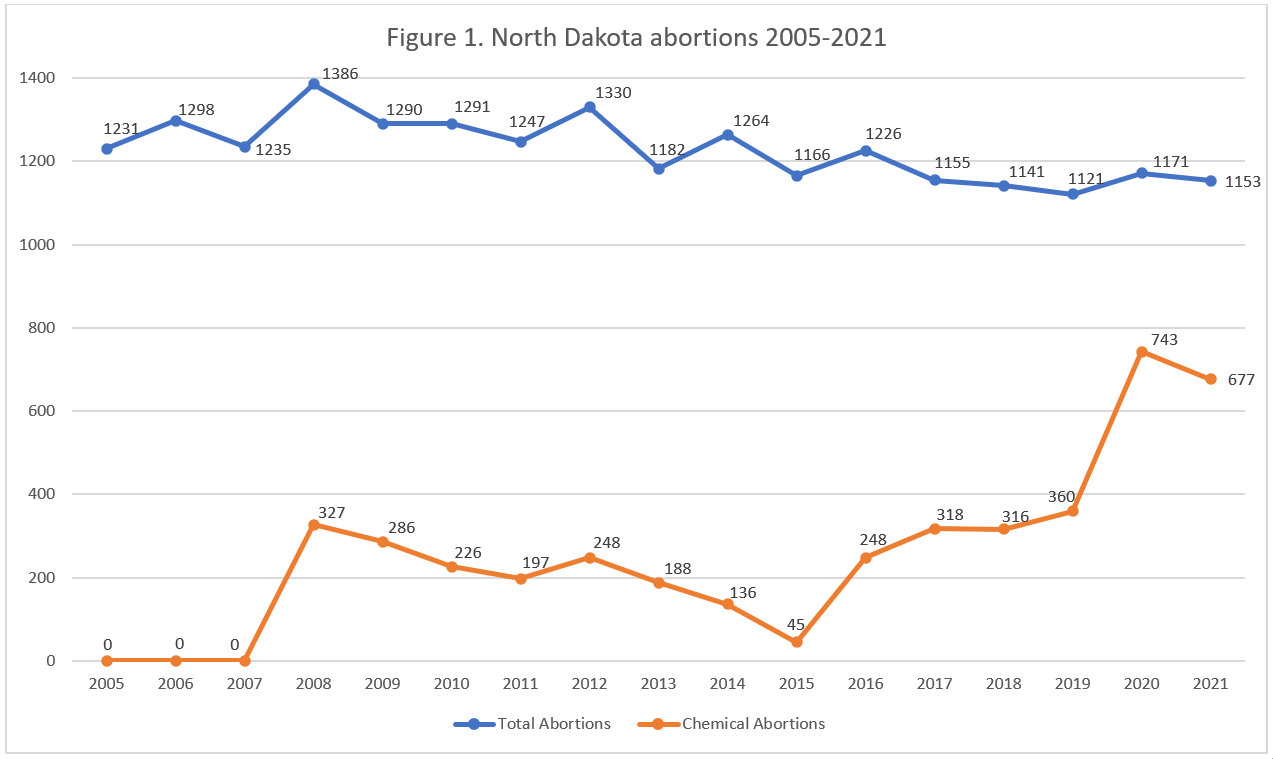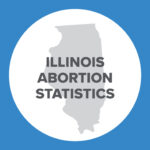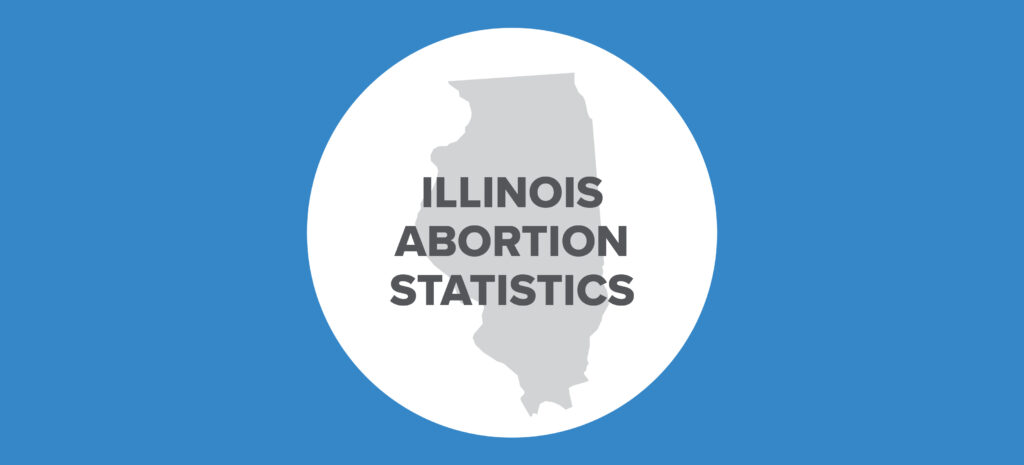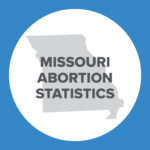Abortion Reporting: North Dakota (2021)
North Dakota published its 2021 abortion report in October 2022. The report shows that the number of abortions in North Dakota slightly decreased from 2020.
Statistics and Changes in North Dakota Abortions, 2020-2021

This report does not include information on Planned Parenthood’s North Dakota abortion market share, but Planned Parenthood operates no centers in North Dakota.
Abortion Totals and Trends
In 2021, there were 1,153 abortions reported in North Dakota, down by one and a half percent from the previous year (Fig. 1). Chemical abortions also decreased, from 743 in 2020 to 677 in 2021 (down 8.9 percent). However, since 2008, the first year North Dakota recorded any chemical abortions, chemical abortion use in North Dakota has increased by 107 percent. The Charlotte Lozier Institute (CLI) estimates that North Dakota’s 2021 abortion rate was 7.6 abortions per 1,000 women ages 15 to 44, a decrease of not quite two percent from 2020 (Fig. 2). As of November 2022, 24 states have released 2021 abortion statistics with 17 reporting increases.
State Report Summary
Seventy-three percent of the abortions that occurred in North Dakota were performed on North Dakota residents while 27 percent of the abortions were performed on nonresidents. A majority (79 percent) of the nonresident abortions were obtained by Minnesota residents. Fifty-nine South Dakota residents obtained abortions in North Dakota and six abortions were performed on residents of other states.
Identical to 2020, ten percent of the abortions reported in North Dakota in 2021 were performed on girls ages 19 or younger. Thirty-two percent of the abortions were performed on women ages 20 to 24, and 27 percent were on women ages 25 to 29. Eighteen percent of the abortions were obtained by women in their early thirties, and 10 percent on women in their later thirties. Two percent of North Dakota abortions were performed on women ages 40 and older.
Fifty-nine percent of the abortions were performed on white women, while 17 percent were on black women and 13 percent were on Native American women. Eleven percent of abortions were on women of other or unknown races. CLI estimates that white women had the lowest abortion rate in 2020 (5.3 abortions per 1,000 women ages 15 to 44), while black women had an abortion rate six times (31.3) that of white women. However, as CLI had previously noted, North Dakota’s abortion reporting form does not include a separate checkbox for abortions performed on Asian women, meaning abortions among this group may be underreported. the number of abortions on Asian women was not reported as such in North Dakota’s 2021 annual report, though they may be included as abortions on women of “unknown” or “other” races.
Thirteen percent of the abortions were performed on women who had not completed high school, while 41 percent were on women with a high school diploma. Seven percent of the abortions were performed on women who had attended some college, and 38 percent were performed on women with an associate degree or higher. Level of education was not reported for just two abortions.
A majority of the abortions reported in North Dakota, 86 percent, were performed on unmarried women, compared to 14 percent on married women. Forty percent of the abortions were on women with no children, while 20 percent were on women with one child and 39 percent were on women with two or more children. Over three quarters (80 percent) of the abortions were performed on women with no previous abortions. Fifteen percent were on women with one prior abortion, and five percent were on women with more than one.
In 2021, North Dakota’s single abortion center performed abortions up until 16 weeks of gestation. However, following the 2022 United States Supreme Court reversal of Roe v. Wade, the sole abortion center in North Dakota stopped performing abortions. In 2021, the vast majority of abortions occurred in the first or early second trimester. Nine percent of North Dakota abortions occurred before six weeks gestation. Twenty-seven percent of the abortions were reported at six weeks, and just over one-third (35 percent) occurred between seven and eight weeks of gestation. Fifteen percent were performed between nine and 10 weeks of gestation, and six percent occurred between 11 and 12 weeks. Comparable to 2020, seven percent of the abortions were reported between 13 and 15 weeks, and just one percent were performed at 16 weeks of gestation.
The month of March had the most abortions (124) while February had the fewest (79). North Dakota’s report does not include the types of procedures used to perform abortions in the state, but this information was provided to CLI upon request. In 2021, 59 percent of the abortions were chemical in nature while 41 percent were suction curettage procedures.
Legislative Changes
In 2007, a trigger law protecting unborn babies at all gestational ages except in the case of rape and incest reported to law enforcement, and when the mother’s life is in danger, was signed into law by Governor Doug Burgum. However, because Roe v. Wade was still legal precedent, the law did not go into effect. In 2019, North Dakota was able to limit abortions after 22 weeks of gestation. The United States Supreme Court overturned Roe v. Wade in June 2022 and North Dakota’s 2007 trigger law was set to go into effect on July 28, 2022 but it was blocked a day before it was set to go into effect . It was blocked again on August 25, 2022, a North Dakota district judge placed another preliminary injunction on the law. When the Supreme Court issued its decision in Dobbs v. Jackson in June 2022, the Red River Women’s Clinic moved to neighboring Moorhead, Minnesota where abortion remains legal. It remains open in Minnesota only, even as its lawsuit in North Dakota is still ongoing.
State Ranking
In 2016, CLI published an analysis of abortion reporting across the 50 states, New York City, and the District of Columbia, and North Dakota’s abortion reports tied for 19th best in the country. North Dakota could improve its reporting of data it already collects by including the types of procedures used to perform abortions in the state in the online annual report. Additionally, North Dakota could collect and report both data on complications caused by abortion and the reasons why women obtained an abortion.


- Rates were calculated by CLI using the following formula: (total number of abortions performed in North Dakota ÷ number of resident women ages 15-44) x 1,000. Rates may differ slightly from previous CLI articles due to revised population estimates. Population estimates were obtained from the CDC wonder database. Estimates for 2005-2009 are intercensal estimates of the July 1 resident population. Estimates for 2010-2019 are Vintage 2020 postcensal estimates of the July 1 resident population. Estimates for 2020-2021 are Vintage 2021 postcensal estimates of the July 1 resident population. Estimates were produced by the U.S. Census Bureau and the National Center for Health Statistics.

























